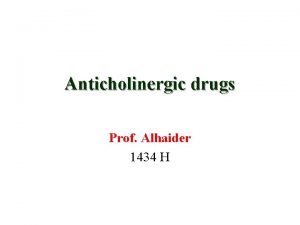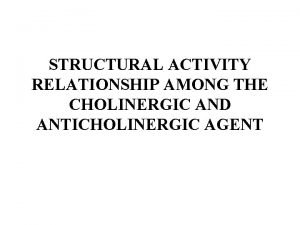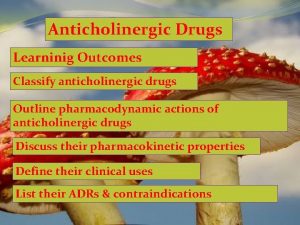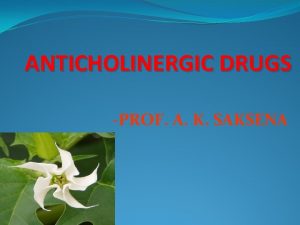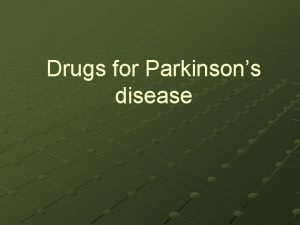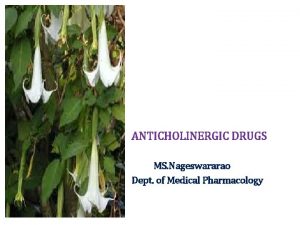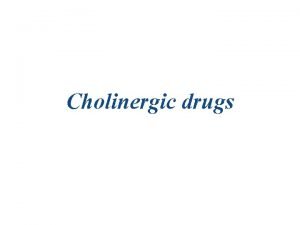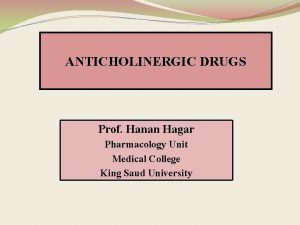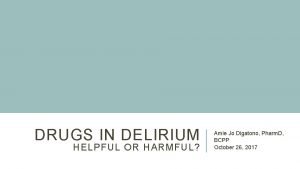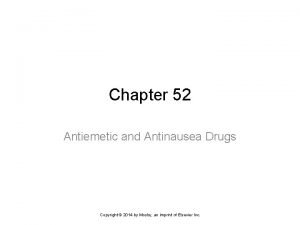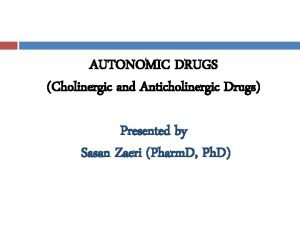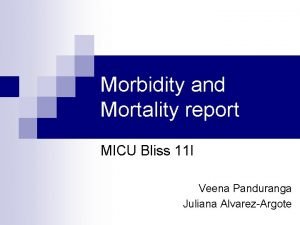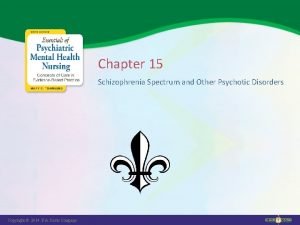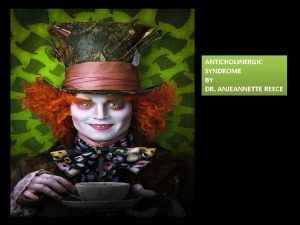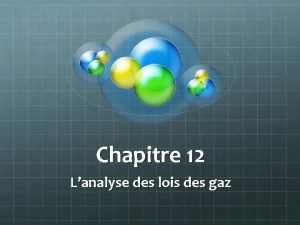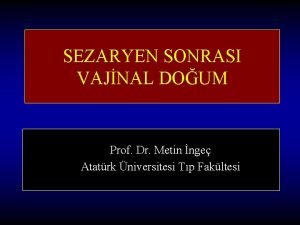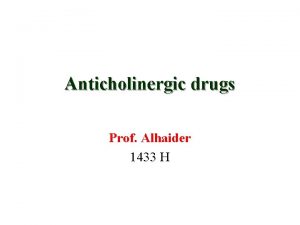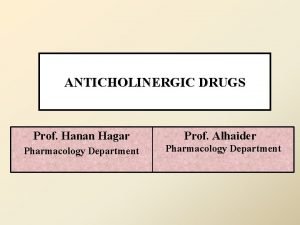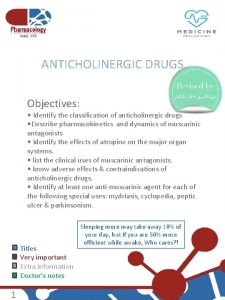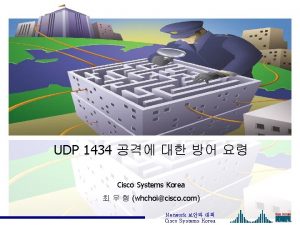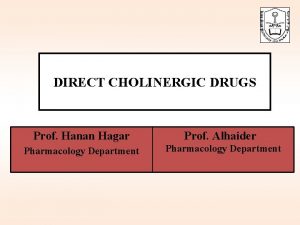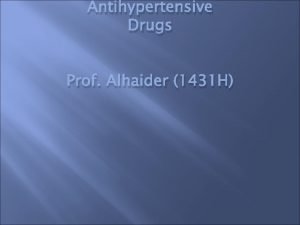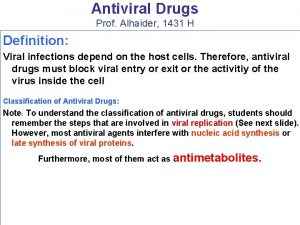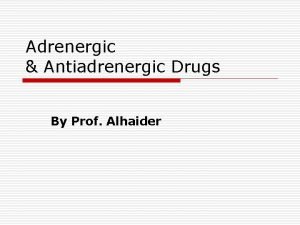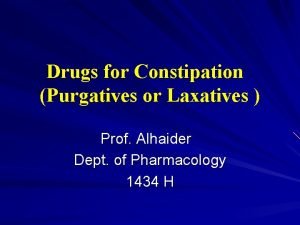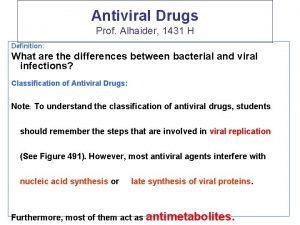Anticholinergic drugs Prof Alhaider 1434 H Anticholinergic drugs

















- Slides: 17

Anticholinergic drugs Prof. Alhaider 1434 H

Anticholinergic drugs Are drugs that block cholinergic receptors.

Anticholinergic drugs Antimuscarinics (Parasympatholytics) Antinicotinics Ganglionic blockers Naturally occurring alkaloids synthetic atropine substitutes Neuromuscular blockers

Muscarinic antagonists (Parasympatholetics) Natural alkaloids • Atropine (Hyoscyamine) • Scopolamine (Hyoscine) • • • Esters of tropic acid and tertiary amines Lipid soluble Why? Good oral absorption Why? Good distribution Cross blood brain barrier (have CNS actions) Why?

Chemistry and PK: What are the differences between Atropine (Hyosyamine) and Scopolamine (Hyosine)? See the last slide What are the differences between tertiary and quaternary compounds in Clinical uses and PK (absorption and distribution)? At which medications the anti-cholinergic effects could be found? Mechanism of Action: Simply, they are competitive and reversible blockers of muscarinic receptors? Some of them like atropine could not distinguish between the subtypes of muscarinic receptors. So What?

• Pharmacological Effects of Antimuscarinics • (Atropine is a prototype) • Note: Simply it is the opposite of the cholinergic actions • 1) Effect on Eye: Blocks muscarenic innervations on the circular muscles (Mydriasis) and relaxes cilairy muscles (Cycloplegia) Increases intra ocular pressure thus worsens glaucoma . Lacrimal secretion sandy eye • What are the clinical consequences of such Pharm. effects?

• • Effects on CVS: – – Mainly, tachycardia due to antagonism of the vagal affect. . No significant effects on atria and ventricles and blood pressure. – What is the clinical significant of such effects? Effects on CNS a. At normal doses: Atropine stimulates modularly centers, while scopolamine produces drowsiness and amnesia. However, at higher doses both of them produce excitement, agitation, hallucinations and coma. b. Anti motion sickness effect (Scopolamine) why not Atropine? c. Anti-tremor activity (Benztropin; Trihexyphenidyl) Actions on the respiratory system a. Decreases bronchial secretion (used as preanesthetic Med; COPD) b. Dilates bronchioles (used for Rx. Asthma)

• Gastrointestinal Effects: – Relaxation of smooth muscles (constipatin). – GIT motility Antispasmodic effect (Buscopan and Propanthelin). – Sphincter contraction • Urinary Tract – Relaxation of smooth muscles of ureters. – Increases Sphincter contraction. Thus leads to Urinary retention Therefore, they are contraindicated for prostate hypertrophy patients.

• Effects on Secretion – A. Salivary secretion (Dry mouth – gastric Acid (used for Peptic Ulcer ) – Sweating Dry skin Fever in infants and children. – Bronchial Secretion (used for COPD)

Cholinergic actions Eye 1. Contraction of circular muscle of iris (miosis) 2. Contraction of ciliary muscles for near vision Heart bradycardia ( heart rate) Urinary bladder Contraction of muscles Relaxation of sphincter Anticholinergic actions 1. relaxation of circular muscles (Mydriasis) 2. relaxation of ciliary muscles (Cycloplegia) loss of accomodation Tachycardia ( heart rate) Relaxation of muscles contraction of sphincter Urinary retention

Cholinergic drugs Exocrine glands Increase of sweat, saliva, lacrimal, bronchial, intestinal secretions GIT peristalsis secretion relaxation of sphincter Lung 1. Bronchoconstriction 2. bronchial secretion Anticholinergic drugs Decrease all secretion peristalsis secretion Contraction of sphincter constipation 1. Bronchodilatation 2. Decrease secretion

Adverse effects Eye: Blurred vision – Mydriasis CVS: Tachycardia - Atropine flush GUT: Urinary retention GIT: Constipation, paralytic ileus Secretions: Dryness of mouth , Sandy eye Increased body temperature. CNS: sedation, hallucination, excitation (Toxic dose). Treatment of Atropine-like Txicity – Gastric lavage. – Anticonvulsant. – Cooling blanket. Antidote: Physostigmine ( IV slowly).

Contraindications – – Glaucoma (angle closure glaucoma) Tachycardia Prostate hypertrophy in old patients. Constipation, paralytic ileus, intestinal obstruction. – Children in case of atropine

Therapeutic applications: a. Central Nervous System Disorders 1. Parkinson’s disease (Benztropine) 2. Motion Sickness (Scopolamine) B. Opthalmological Disorders: e. g: Homatropine 1. Accurate measurement of refractive error in uncooperative patients (e, g: children) (Ciliary paralysus) 2. Examination of retina (Mydriasis)

C. Respiratory Disorders: History: Inhalation of smoke from burning leaves of Datura stramonium as remedy of B. Asthma. Thus, Ipratropium as inhalation (or Tiotropium) are commonly used for Asthma and COPD. Why not Atropine? D. CVS (Atropine) for cardiac arrest How? E. GIT: 1. Peptic Ulcer: Pirenzepine (selective M 1) 2. As Anti-spasmotic Buscopan; Propantheline (IBS) F. Urinary Disorders: To Rx incontinence (Imipramine; Oxybutynin)

What is difference between atropine and hyoscine? Hyoscine (SCOPOLAMINE) has • Shorter duration of action • More CNS depressant action • Antiemetics action in motion sickness • Can produce amnesia. • Less CVS effect

Good Luck Any Questions Mobile: (0505281200) Or aqahaider@hotmail. com qalhaider@ksu. edu. sa
 Anticholinergic drugs
Anticholinergic drugs Structure activity relationship of cholinergic drugs
Structure activity relationship of cholinergic drugs Classify anticholinergic drugs
Classify anticholinergic drugs Anticholinergic drugs
Anticholinergic drugs Classification of anticholinergic drugs
Classification of anticholinergic drugs Anticholinergic drugs mechanism of action
Anticholinergic drugs mechanism of action Anticholinergic effects
Anticholinergic effects Classification of anticholinergic drugs
Classification of anticholinergic drugs Anticholinergic drugs mechanism of action
Anticholinergic drugs mechanism of action Tropicamaide
Tropicamaide Anticholinergic examples
Anticholinergic examples Emetrol mechanism of action
Emetrol mechanism of action Anticholinergic examples
Anticholinergic examples Berman
Berman Types of psychotic disorders
Types of psychotic disorders Anticholinergic syndrome
Anticholinergic syndrome R = 8 314
R = 8 314 Prof dr metin ingeç
Prof dr metin ingeç
